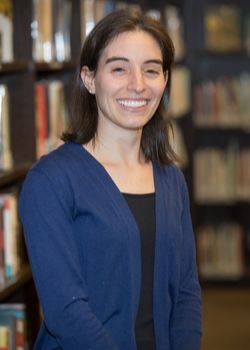On a walk around my neighborhood last week, I noticed a lot of decorations on people’s lawns. An inflatable Santa, snowman, and reindeer; an inflatable dreidel and a menorah; at night I see fences light up with multi-colored lights. This is the season of lawn decorations. We all know about specific blocks to visit that have the best holiday decorations that we admire with delight.
The rabbis tell us that the mitzvah of lighting the candles can only be fulfilled as long as people are out and about on the streets so that they can see the lights shining in your home. Chanukah is about publicizing the miracle from inside your house (or right outside your house). This is an interesting time to be thinking about the private space and the public space. We’ve been spending so much time in the privacy of our homes that even lawn displays for children’s birthdays, to be seen by all, still feel private. And yet, the lines are blurred as we’ve spent time on Zoom, peering into the insides of homes and bedrooms of our friends and colleagues.
In recent sessions of our master's course devoted to teaching Judaic studies, we explored ways of teaching Jewish holidays. Dr. Ron Wolfson talked about the importance of relationships, meaning-making, and memory in teaching about holidays and helping learners connect to holidays. The next week we were joined by artist Hillel Smith, who challenged our students to consider the potential of art and the study and creation of ritual objects to help learners uncover the essence of the holidays. Our students were fascinated by an exploration of the Sukkah City project and how artists created Sukkot that reflected their understandings of the holiday and the themes most significant to them, such as welcoming, protection, and others. I’ve been thinking about how both of these approaches could be used this year as we celebrate and teach Chanukah.
On one level, we can help learners (of any age) connect with Chanukah in a meaningful way through recalling memories and creatively accessing the mitzvot and customs of the holiday. We can also invite learners to create ritual objects that embody this meaning or their understanding of the holiday and represent it to others. This is the private. On another level, we encourage our students to publicly share these experiences and use their creations as additional opportunities for connection and meaning-making. For example, an assignment to create a Chanukiah that reflects a theme of the holiday could, as one student suggested, be a Chanukiah created out of strong and weak materials as an exploration of the theme “the strong versus the weak” told in the story of the Maccabees. Another student wrote a lesson that involved young learners expressing their uniqueness in the world by fashioning candles using symbols and images that reflected their values. This activity focused on both recognizing the light in ourselves and in others, as well as encouraging students to contemplate how to expose the light of others and merge each other’s uniqueness to spread even more light.
This year on Chanukah, a holiday whose central mitzvah is still pirsumei nisah, our conceptions of public and private have shifted. As we celebrate perhaps the most private Chanukah of our lives, a Chanukah where we are physically apart, how can we reimagine the public nature of the holiday? What does it mean to spread our light?
Happy Chanukah!

